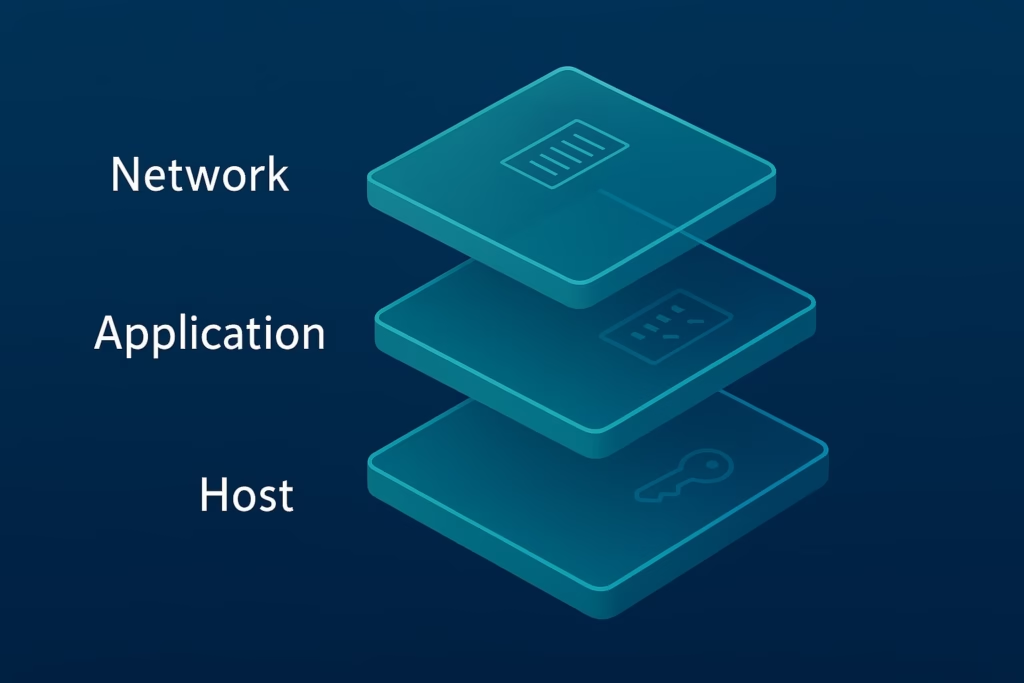What is a Firewall and Why Do You Need One?

Introduction
Firewall security is a foundational element of any strong cybersecurity strategy. Whether you’re a home user protecting a single device, a small business shielding customer data, or an enterprise managing thousands of endpoints, understanding firewall security helps you control traffic, limit exposure, and respond to threats. This guide explains what a firewall is, how firewall security works, different types of firewalls, common threats, practical deployment strategies, and a checklist you can use today.
What is a firewall?
A firewall is a system — hardware, software, or both — that enforces a set of rules about which network traffic is allowed to enter or exit a protected environment. The core purpose of firewall security is to create a controlled boundary that separates trusted internal networks from untrusted external networks. Firewalls examine packets, connections, and application behavior to decide whether to permit or block traffic.
Basic concepts in firewall security
Packet filtering
Packet filtering is the simplest form of firewall security. It inspects packet headers for protocol, source and destination IP addresses, and port numbers, applying rules that either allow or deny packets. Packet filters are fast and lightweight, but they lack deep insight into application behavior.
Stateful inspection
Stateful firewalls track active connections and maintain a session table. By remembering the state of connections, stateful firewall security can allow return traffic for legitimate sessions while blocking unsolicited attempts. This provides better context than packet filtering.
Application-layer filtering
Application-layer firewall security inspects the content of traffic up to the application layer. This allows policies to be based on specific application behavior, such as HTTP methods or SQL queries, and is crucial for defending against modern web-based attacks.
Types of firewalls
Network firewalls
Network firewalls sit at the boundary between networks — for example, between a corporate LAN and the internet. These devices are optimized for throughput and enforce organization-wide firewall security policies.
Host-based firewalls
Host-based firewall security runs on endpoints (servers, desktops, mobile devices). They enforce local policies and can filter traffic even when devices connect to untrusted networks. Host firewalls are essential for layered defense.
Next-generation firewalls (NGFW)
Next-generation firewall security combines traditional filtering with integrated intrusion prevention, application awareness, and even some forms of user identification and sandboxing. NGFWs are designed to handle modern threats at scale.
Web application firewalls (WAF)
A web application firewall provides specialized firewall security for web applications, protecting against SQL injection, cross-site scripting, and other application-layer attacks by analyzing HTTP/HTTPS traffic.
How firewall security works — core mechanisms

Rules and policies
At a basic level, firewall security is rule-driven. Administrators define rules that permit or deny based on IP addresses, ports, protocols, and higher-layer attributes. A well-structured rulebase reduces complexity and prevents policy gaps.
NAT and port forwarding
Network Address Translation (NAT) and port forwarding are common functions managed by firewall security appliances. NAT hides internal address spaces, while port forwarding opens specific services to external access under controlled conditions.
Deep packet inspection
Deep packet inspection (DPI) examines packet payloads to detect malicious content or enforce content policies. DPI is a powerful firewall security feature, but it can raise performance and privacy considerations.
Logging and monitoring
Firewall systems log events, connections, and alerts. Centralized logging with correlation and SIEM tools helps security teams spot trends, investigate incidents, and comply with regulations.
Why you need firewall security

Reduce attack surface
Firewalls reduce the number of potential attack vectors by closing unused ports and limiting which services are exposed. This is firewall security 101 — the fewer entry points, the harder it is for attackers to find a path inside.
Prevent unauthorized access
Properly configured firewall security blocks unauthorized attempts to access internal resources. Whether the threat is a remote attacker or a misconfigured device, firewalls act as gatekeepers.
Enforce segmentation and least privilege
Firewalls enable network segmentation — splitting a network into smaller zones with distinct policies. This supports the principle of least privilege, limiting lateral movement if a breach occurs and containing potential damage.
Improve compliance posture
Many compliance standards and regulations require firewalls as part of a security baseline. Effective firewall security demonstrates due diligence for auditors and regulators.
Common threats and firewall security limitations
Misconfiguration
Misconfigured firewall rules are a leading cause of breaches. Overly permissive rules, forgotten exceptions, or unmanaged devices can effectively nullify firewall security measures.
Sophisticated application attacks
A traditional firewall may struggle against advanced attacks that exploit application logic or user behavior. That’s why application-layer controls and WAFs are important additions.
Encrypted traffic
TLS/SSL encryption hides traffic content from ordinary firewall security. Decrypting traffic for inspection (with proper privacy considerations) or using endpoint controls becomes necessary for full visibility.
Insider threats
Firewalls cannot fully prevent actions by authorized users. Firewall security must be complemented by identity controls, endpoint protection, and monitoring to manage insider risks.
Planning firewall security for different environments
Home users and small offices
For home and small office environments, firewall security can be achieved using a router with robust NAT, a simple packet-filtering firewall, and host-based firewalls on devices. Prioritize default-deny rules for incoming traffic, automatic updates, and a secure admin password.
SMBs and growing businesses
SMBs benefit from a mix of network firewalls, host-based protections, and centralized logging. Use segmentation to separate guests, corporate devices, and servers. Implement VPN controls with firewall security to protect remote access.
Enterprises
Large organizations should adopt layered firewall security — NGFWs at the perimeter, internal segmentation firewalls between zones, WAFs for web services, and host-based controls on endpoints. Integrate with SIEM, identity providers, and automated response tools.
Best practices for firewall security

1. Adopt a default-deny posture
Start with everything blocked and allow only what is explicitly required. Default-deny is a core firewall security principle that minimizes exposure.
2. Keep rule sets simple and well-documented
Complex rulebases become unmanageable. Document each rule, its owner, and its justification to avoid rule sprawl and risky exceptions.
3. Use segmentation and micro-segmentation
Segment networks by function and sensitivity. For high-value assets, consider micro-segmentation with host-based firewall security to isolate workloads.
4. Regularly audit and test configurations
Perform scheduled audits, penetration tests, and red-team exercises. Automated configuration drift detection tools help maintain firewall security posture.
5. Implement centralized logging and SIEM integration
Centralize logs from firewalls and correlate them with other telemetry. SIEM integration accelerates detection and investigation.
6. Protect management interfaces
Restrict access to firewall management consoles with VPNs, IP whitelists, and multi-factor authentication. Protecting management is critical to maintaining firewall security.
7. Monitor encrypted traffic safely
Use selective TLS interception with clear policies and privacy safeguards, or rely on endpoint telemetry when decryption isn’t feasible.
Firewall security for cloud and hybrid environments
Cloud architectures require cloud-native firewall security tools in addition to traditional controls. Use cloud security groups, WAF services, and cloud-native network policies. For hybrid deployments, ensure consistent firewall security policies and logging across on-prem and cloud.
Firewall security and remote workers
Remote work expands exposure and complicates firewall security. Use VPNs, zero-trust network access (ZTNA), and endpoint verification so that remote devices meet security standards before accessing resources. Combine firewall security rules with identity-aware policies.
Incident response involving firewall security
Detection and containment
When an alert fires, use firewall security logs to identify malicious connections and block IPs or segments immediately. Containment through segmentation reduces lateral spread.
Forensics and recovery
Preserve firewall logs and snapshots to reconstruct attacker paths. Firewall security logs often reveal the initial access vector and help inform remediation and notification steps.
Post-incident improvements
After remediation, perform root-cause analysis and update firewall security policies, close unnecessary ports, and patch related systems to prevent recurrence.
Choosing the right firewall solution
Assess throughput and performance needs
Match firewall security appliances to your network volume and latency requirements. Underpowered firewalls create bottlenecks and degrade performance.
Evaluate feature sets
Look for NGFW features, WAF integration, centralized management, and cloud compatibility. Also consider support for automation and APIs for policy orchestration.
Consider vendor ecosystem and support
Vendor maturity, security updates, and active communities matter. Strong support reduces time-to-fix for vulnerabilities and improves firewall security over the product lifecycle.
Cost considerations
Firewall security ranges from free host-based options to enterprise appliances. Consider total cost of ownership: hardware, licensing, staffing, monitoring, and incident response. Sometimes cloud-native firewall security services offer cost-effective scaling compared to on-prem deployments.
Practical firewall security checklist
- Inventory all firewalls and rule sets.
- Apply a default-deny policy for incoming traffic.
- Remove unused rules and orphaned exceptions.
- Use multi-factor authentication for management access.
- Enable centralized logging and alerts.
- Schedule regular rule and vulnerability audits.
- Protect VPN access and enforce endpoint compliance.
- Test backups and device restore procedures.
- Deploy WAF for public web applications.
- Use threat intelligence feeds to block known bad actors.
Common myths about firewall security
Myth: Firewalls are enough on their own
Reality: Firewalls are necessary but not sufficient. They must work with endpoint protection, IAM, and monitoring to create effective defense-in-depth.
Myth: More rules equal better security
Reality: More rules often mean more complexity and higher risk. Simpler, well-justified policies usually deliver stronger firewall security.
Myth: Firewalls block all malware
Reality: Firewalls can block network-based threats, but many malware strains use legitimate protocols to exfiltrate or hide. Combine firewall security with antivirus, EDR, and network detection.
Future trends in firewall security
Zero-trust and identity-aware proxies
Firewall security is moving toward identity-aware controls that authorize access based on user and device posture rather than network location.
SASE (Secure Access Service Edge)
SASE converges networking and security into cloud-delivered services. Firewall security becomes a distributed, cloud-native capability integrated with access controls and threat protection.
AI-assisted policy tuning
Machine learning can help suggest optimized firewall security rules and detect anomalies. However, human oversight remains essential to avoid risky automated changes.
Conclusion
Firewall remains a cornerstone of modern cybersecurity. Properly configured firewalls reduce attack surface, enforce segmentation, and provide critical telemetry for detection and response. But a firewall is not a silver bullet; it must be part of a layered approach that includes identity controls, endpoint protection, secure development practices, and continuous monitoring. Follow the checklist, adopt a default-deny posture, and treat firewall security as an ongoing program, not a one-time setup.
Related Posts from CyberNet24
- Cybersecurity for Remote Workers — securing remote access and endpoint hygiene.
- How to Choose a VPN — VPN selection and configuration tips.
- Importance of Software Updates — patching strategies to reduce vulnerabilities.
Recommended External Resources
- NIST — Network Security Guidance — standards and best practices relevant to firewall security.
- OWASP — Web Application Firewall Guidance — resources for protecting web applications and APIs.
- CISA — Cybersecurity Guidance — incident response and infrastructure protections.



